Doubles from Trinidad, a Sandwich with a Story
Doubles are a delicious, cheap, and vegan street food, popular in the Caribbean nation of Trinidad and Tobago.
Hm. Informative, but dry. Let’s try again.
I rode to Cafe Trinidad (warning: site plays music) in Chicago’s Bronzeville neighborhood after work one day, in the cold and dark and wet of early December. I’d called earlier and been told that they did serve Doubles every day, but not until evening. Chicago’s other Trinidadian restaurant, Taste of Trinidad (this site also plays music) way up on the border with Evanston, only served them on the weekend and I didn’t want to wait. So I earned those pre-dinner calories with the bike ride, though I’d have been able to get there more comfortably and easily via the Green Line.
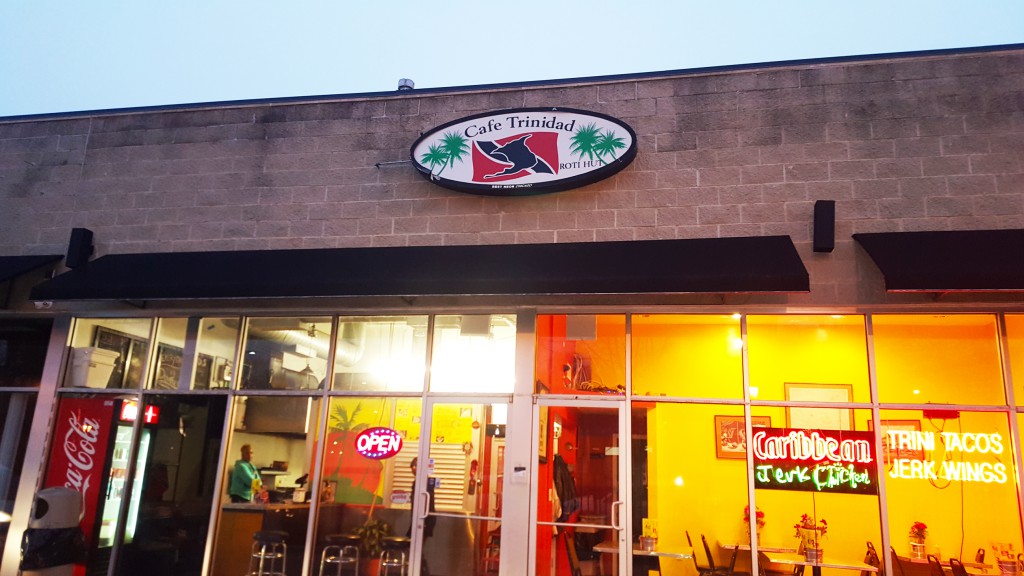
A woman getting carryout at the counter turned and said something to me as I entered, still removing my bike helmet and balaclava. I had to ask her to repeat it. “You didn’t let me pose!” she said, referring to the photo I’d taken of the storefront before entering. “No worries, you looked great,” I replied. She smiled and said, “Thanks handsome,” on her way out.
I ordered a doubles to eat in the restaurant and several to take home and share, along with some curry goat (because I couldn’t pass it up). One thing I’ve noticed in researching doubles, mostly by perusing the Facebook fan page, is that no matter how delicious the sandwich may be, the photos mostly look like dirty diapers. The sandwiches are assembled in wax paper that’s immediately twisted shut with a practiced flip once they’re done, resulting in a lot of smooshing and smearing. Photogenic these sandwiches are not.

That’s two bara, or fried flatbreads, yellow from the addition of turmeric and curry spices, wrapped around channa or curried chickpeas. Cafe Trinidad also adds two of the more common condiments, a sweet/sour tamarind sauce, and a garlicky and extremely spicy hot pepper sauce.
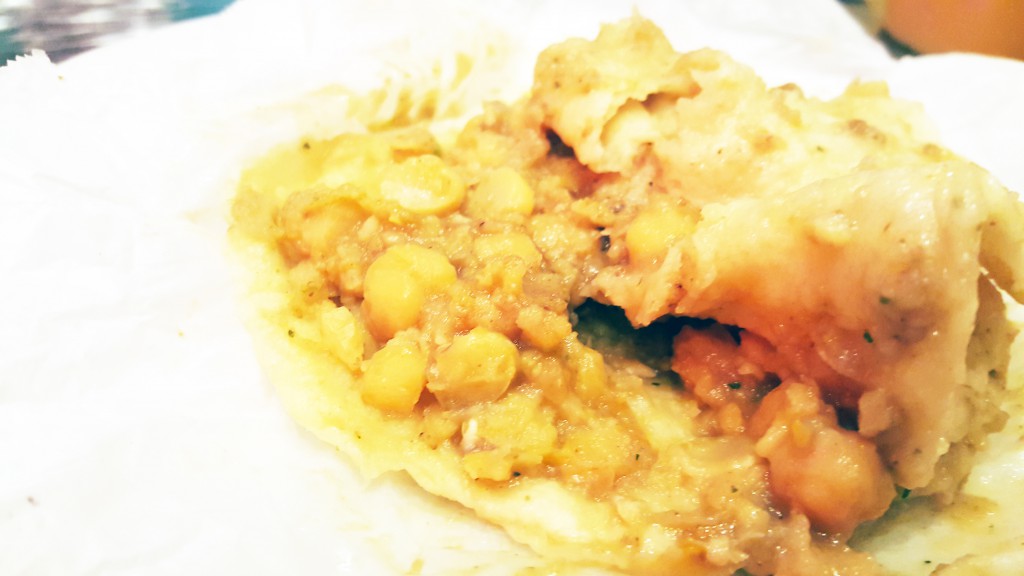
I sat and ate that sloppy, delicious sandwich in the restaurant while they prepared my to-go doubles. They packed the ingredients separately for those, since the steam from the channa would soak into and half-disintegrate the wax-paper-wrapped bara otherwise. I washed my hands and face, and attempted to buy a bottle of their house-made hot pepper sauce (they were out, sadly) before leaving and hopping on a bike to head for the train station and home.
While riding home on the train, I received a call. It was Cafe Trinidad. “Did you just come in here less than an hour ago and order doubles?” she asked. I said yeah, that had been me. “Did you… leave something here?”
My wedding ring. I’d taken it off in the bathroom when I washed my hands, and had forgotten to put it back on. This kind woman had remembered my call from earlier in the day and gone back through caller ID records until she found my number in an effort to make sure I wouldn’t lose my ring. She sealed it in an envelope and held it for me at the counter until I was able to make it back to the restaurant the next day.

It’s not much of a story, but it’s something I’ll always remember about Cafe Trinidad, and part of the story I’ll tell myself about that day in the future. The friendly, welcoming service. The flirtatious customer. The menu board proclaiming EVERY DAY DOUBLES $3. The delicious chickpea-and-flatbread sandwich. The surprisingly tender chunks of bone-in goat in a spicy stew. And the honesty that made them go to the effort to get my wedding ring back to me.
Back in August, I wrote a piece of which I was particularly proud about the history of the club sandwich (a piece which was recently named one of the best long-form food stories of 2015 by Helen Rosner at Eater, thanks Helen!) In a conversation with my mother, I mentioned to her that I thought it might be the best story I’d done for this site. She disagreed, saying she preferred my posts when they were more of a story about my family encountering a new sandwich, rather than a dry history of the sandwich itself.
It got me thinking about food and storytelling and the meeting of the two. The world is an endless supply of sensory stimuli, but sensation alone is a bland gruel for our minds. Narrative is the spice we use to turn a morning of waiting in line at the DMV into a memory, a story we tell our friends, our partners, ourselves.
Similarly, I can never look at an elaborately presented crown roast without remembering my mother’s stories of family meals growing up, or at an ice cream treat without remembering the ever-present Eskimo bars in my grandmother’s freezer. We tell ourselves food stories about our major feast days, the turkey at Thanksgiving, the ham at Easter, the lasagna on New Years Day. (That one may just be my family though)
I still think that my history of the club sandwich is one of the best things I’ve ever done on this site, but my mom has a point. We like our food to have its own stories, to connect it to ourselves, our families, and our lives.
Doubles are a sandwich with a story. That story, according to Badru Deen, author of Out of the Doubles Kitchen: A Memoir of the First Family of Doubles – The Number One Street Food of Trinidad & Tobago, is a story that starts with a poverty born of colonialism and indentured servitude, wends its way through alcoholism and domestic abuse born of that poverty, weaves in family feuds and tragedies; births, marriages, deaths; emigration and repatriation; illiteracy, anti-intellectualism, and education; the complex classism and racism of the colonial Afro-Indo-Caribbean society where this sandwich was born and the simpler but equally harmful racism encountered in the predominantly Eurocentric Canada to which the author relocated in his early adulthood. Through it all runs a common theme of a generations-old resentment of his uncle, the founder of a large chain of Doubles stands in Trinidad, who he says unfairly claimed to have invented the product pioneered by his father.
Yet the early chapters especially are fascinating reading, from an outsider’s perspective–a picture of a culture being born and the early stages of the mainstreaming of a poverty-level street food. Though the book’s title may namecheck the sandwich, it is at heart a memoir of a man and his family. Deen’s story of Doubles cannot be told without the story of the Deen family.
There is a simpler Doubles story though, that doesn’t require an entire book to tell. Street vendors used to sell a piece of bara flatbread topped with channa, or chickpea curry. Customers started asking for a second piece of flatbread on top. This came to be known as Doubles, for double bara with channa.
Given my musings about stories, it’s not surprising that when searching for a recipe to replicate Doubles in my home, I looked more for an interesting story than an interesting recipe. And when I found my story, it didn’t contain a recipe at all. A blogger named Ranette wrote on a website called Love Loretta’s Kitchen about her childhood visits with family in Trinidad, and about their preference for a specific Doubles vendor, and promised the best recipe for Doubles–the bara, the channa, the chutney–but ended without posting the actual recipe!
I contacted Ranette and received not only her recipes, but her generous permission to share those recipes with you.
Tambran
I started with her recipe for Tambran, or tamarind sauce, which I was able to find on her website. You can click that link to find the actual recipe, which starts with 10 tamarind pods.

These pods are shelled and rinsed before being simmered in water to soften them and separate the seeds from their husks.
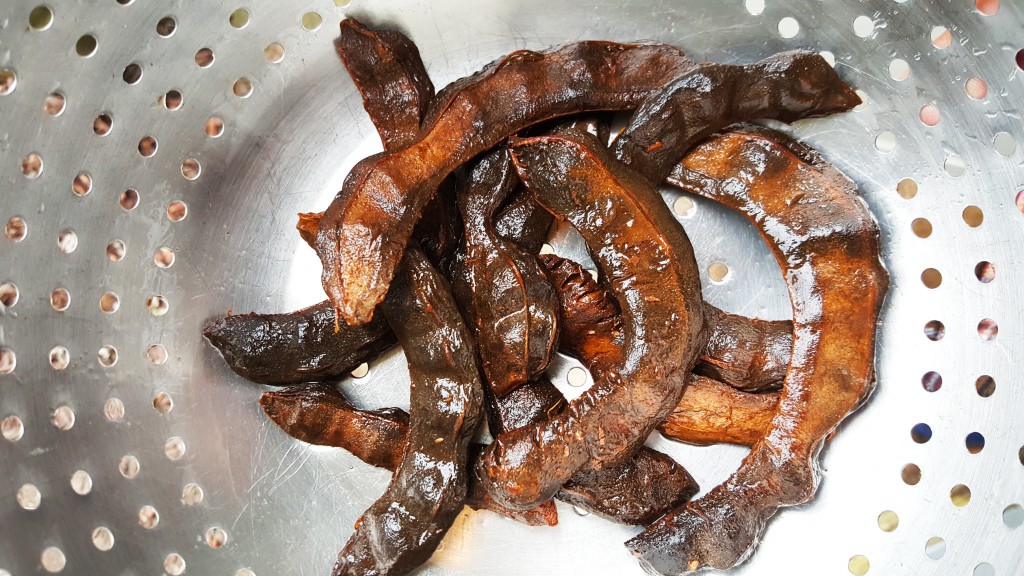
Perhaps the tamarinds I’m able to get at my local store are more dried-out than those closer to the source would be, but I found that it took longer than 5-7 minutes to reduce the fruits to a pulp that could be pushed through a strainer. The tamarind flesh is quite fibrous, and what’s left in the strainer resembles a dark sticky wool. I appreciated the final result though, less sweet than the tamarind chutneys I’ve had with Indian food, tart, thick, and mildly spicy.
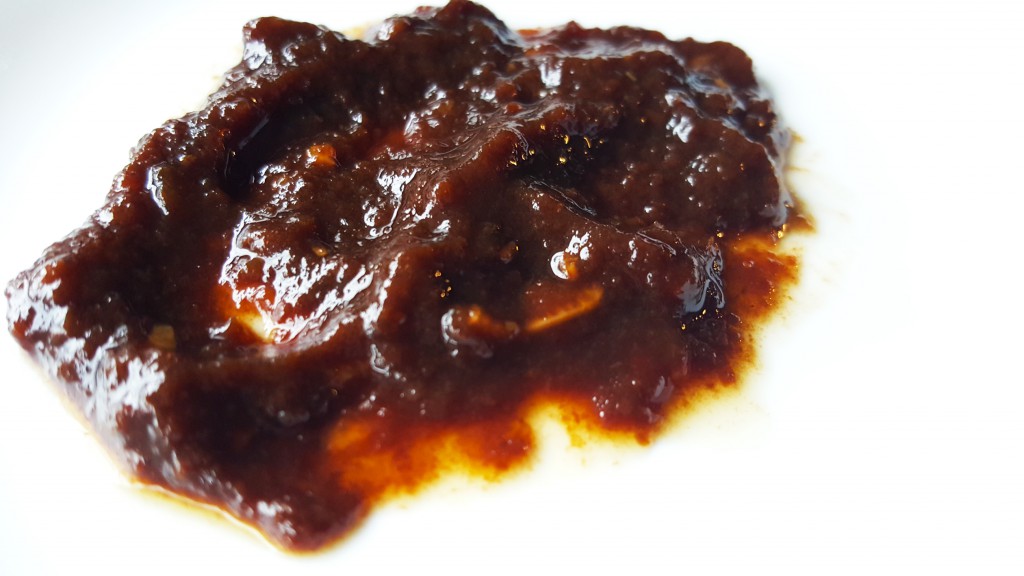
Next, I made Ranette’s Cucumber chutney. This particular condiment hadn’t been part of Cafe Trinidad’s offering, and I felt like a fresh, crisp vegetable ingredient would improve the already delicious sandwich I’d experienced, so I was eager to give this a go.
The text of the following recipes are copied directly from what Ranette sent me, with my own photos and my notes added at the bottom of each recipe. Thank you very much, Ranette and Love Loretta’s Kitchen, for sharing!
Ranette’s Cucumber Chutney
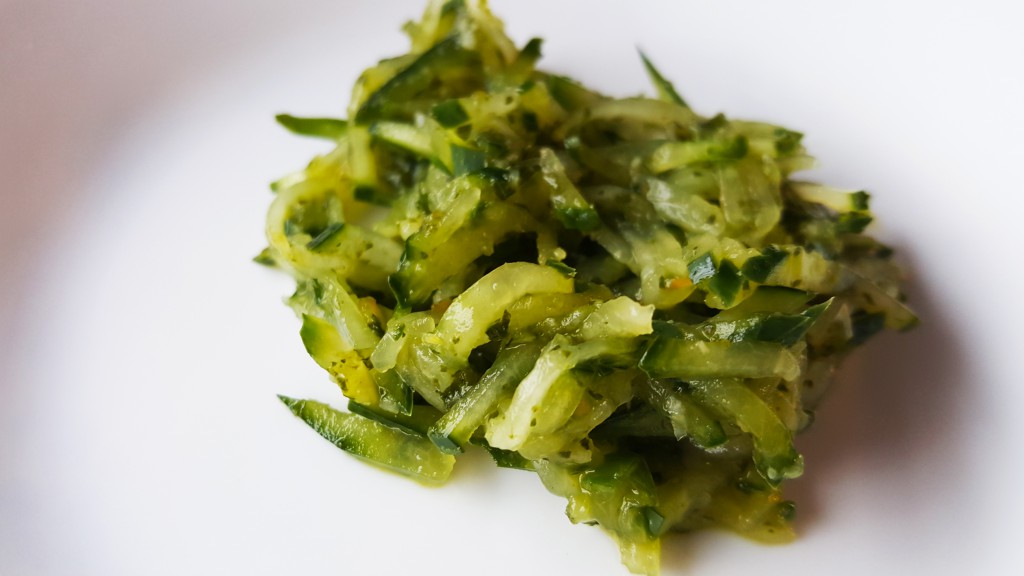
Ranette’s Cucumber Chutney
Ingredients
- 1 Cucumber – finely sliced with a julienne peeler preferably
- 2-3 Garlic cloves
- Juice of 1 Lime
- 1/2 tsp scotch bonnet pepper
- 1/2 tsp Brown sugar
- 1-2 tbsp Coriander. freshly chopped
Instructions
- Take all the ingredients, grated, crushed and juiced, stir them lovingly into a bowl.
- Season to taste if necessary.
Notes
Next was the channa, which I felt (correctly) would reheat well once the bara were prepared.
Ranette’s Curry Channa
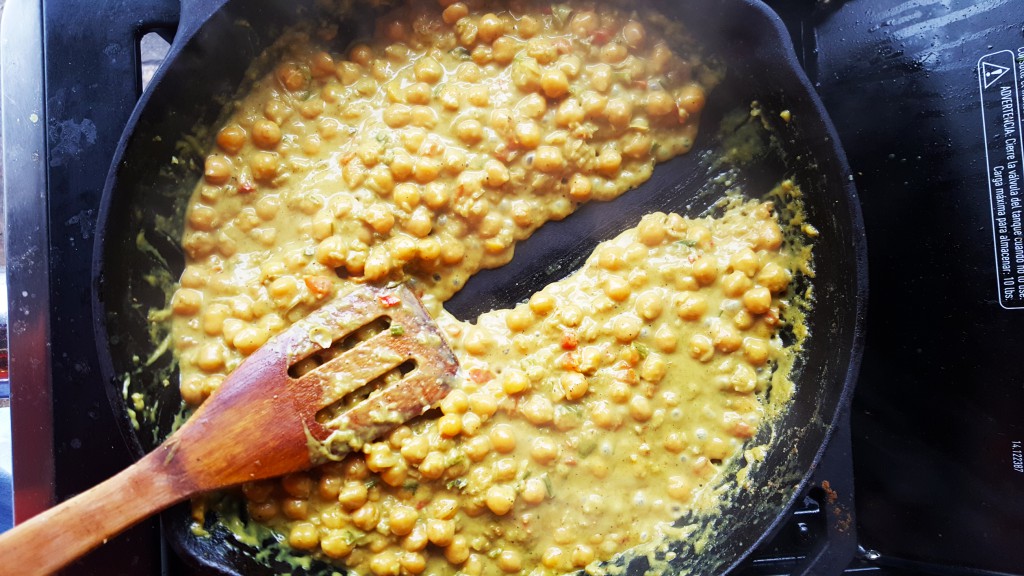
Ranette’s Curry Channa
Ingredients
- 1 tin of Chick Peas keep the salted water for later
- 3 cloves Garlic crushed
- 1/2 medium Onion – grated
- 2 Spring onions – finely chopped
- 1 tbsp of Sweet red pepper finely chopped
- 1-2 tbsp of Patak’s Madras Curry paste or Chief Curry Powder
- 1/2 tsp of Cumin powder Geera
- 1/4 cup Coconut Milk optional
- 1 tbsp Olive oil
Instructions
- Take the onions, garlic and red pepper with the oil and fry gently in a saucepan. The onion may take a while to fry, as you have grated it and so some of the water would have to dry out. This should take 2 minutes.
- Then add the curry paste or powder, cumin, lower the heat and fry with the onions for 1-2 minutes.
- Then add the drained chick peas to the curry mixture and stir the peas in so that the curry coats the peas completely. Allow it to cook for 2-3 minutes.Then slowly add the chick pea water, you may not need all of it, just enough to get the right consistency, I used about 3/4 of the water.After 1 minute I added the coconut milk and seasoned to taste. Allow it to boil slowly for another 5-8 minutes.
Notes



Finally, with my other ingredients made (and the necessary Trini hot pepper sauce acquired via Amazon–I ended up ordering Matouks, a common brand in Trinidad), it was time to make my bara.
Ranette’s Bara
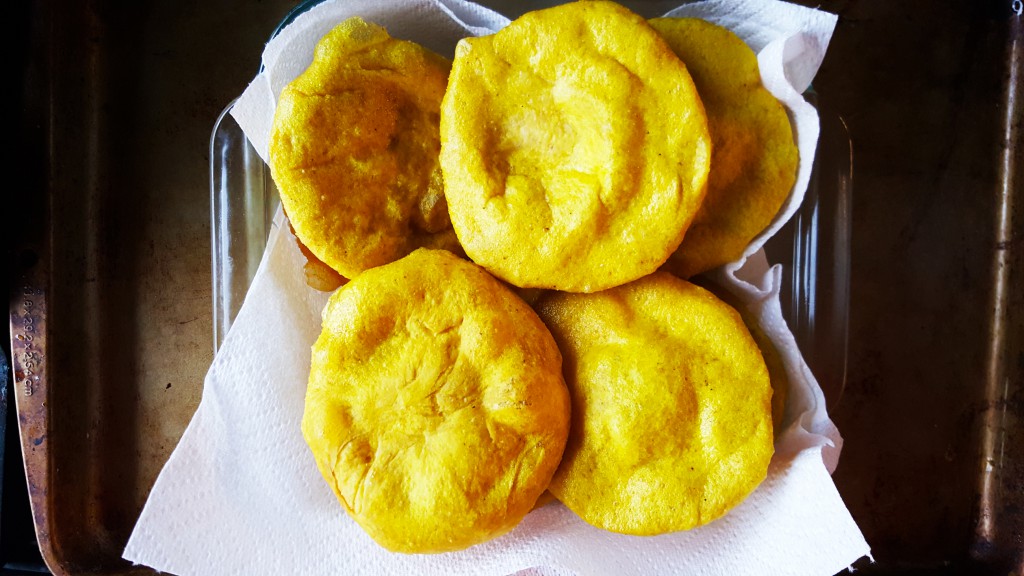
Ranette’s Bara
Ingredients
- 2 cups strong white bread flour
- 1/2 tsp Salt
- 1 tsp Curry powder
- 1/2 tsp Turmeric
- 1 tsp Gheera cuminpowder
- 1 tsp instant yeast
- 1/3 Cup warm water
- 1/4 tsp Sugar
- Oil for frying
Instructions
- In a large bowl combine the flour, salt, curry powder, turmeric and cumin.
- In a separate small bowl place the warm water, sugar and yeast, stir and leave to foam for 5 minutes.
- Add the yeast mixture to the flour to make a slightly firm dough. Knead it for 3 minutes and then place in an oiled bowl, covered with a damp cloth and allow to rise for 1 1/2 hours (in a warm place preferably, not in direct heat).
- When the dough has risen, take the dough and punch the air out of it on a floured surface.
- Divide the dough into 8-10 pieces and then shape each piece into a tight ball. Again place the dough balls under damp cloth and let it rest for 15 minutes.
- Then with a bowl of warm water, moisten your fingers take a dough ball and flatten it to a round base, 4 or 5 inches in diameter. The dough should still be moist at this time. You should be able to fit only 3 in the frying pan to give you an idea of their size.
- Take a frying pan and fill it with 2″ of oil. Heat the oil to a medium – high heat.
- Place 3 of the bara’s in the oil, it should take no more than 30 seconds to cook each side, the bara. Place the bara in a warm oven while you fry the rest.
Notes

Assembling the Doubles
The videos I’ve seen of Doubles being assembled by experienced Doublesmen are quite something. One hand holds a piece of wax paper and the other quickly throws 2 bara into it, slightly overlapping. That hand then quickly spoons in the channa and whatever condiments have been requested. Then the wax paper is folded to close the sandwich, the corners are grasped, and the package is quickly flipped to twist it shut. The entire process takes no more than a few seconds per Doubles.
For my first Doubles, I was going to take a bit more time. I started with a single bara, on a plate.

Then I added the tamarind sauce

the chickpea curry
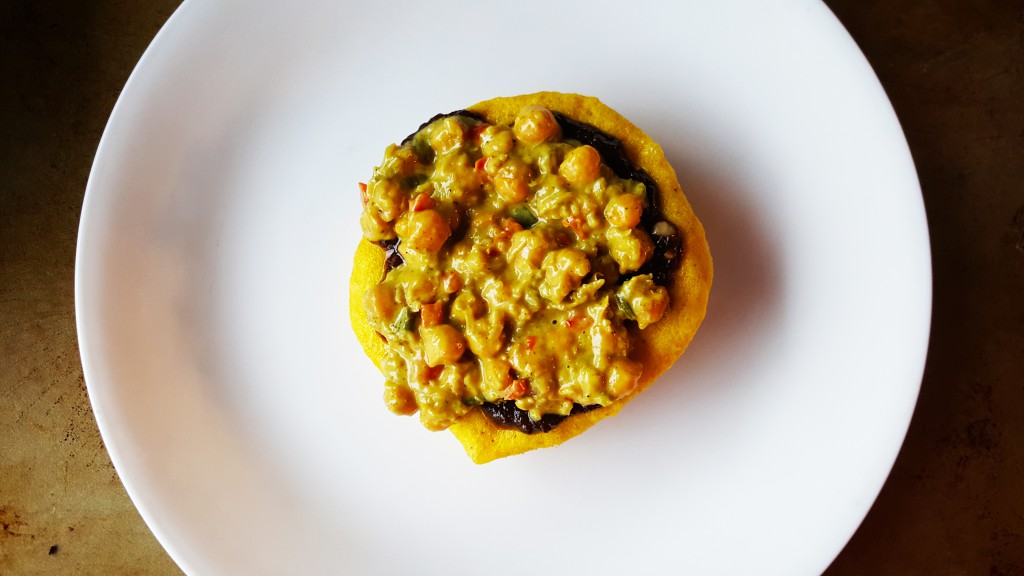
the hot pepper sauce

and the cucumber chutney

before adding the second piece of flatbread.

As neat as I made the process of assembling the Doubles, at least compared to the quick assemblies done by the pros in Trinidad, while eating the sandwich I was glad to have the plate underneath, and quickly reached for a fork. This is an outstanding combination of flavors, and much improved by the addition of the cucumber chutney, but it is a 5-napkin mess and you’ll be eating chickpeas off your plate.
Afterward, I made a more traditional version.

Eating the sandwich out of wax paper eliminates (or greatly reduces) the drip factor, but it’s still not what I would call a neat sandwich, and what isn’t retained by the wrapper will end up on your hands, wrists, and forearms. There must be a trick to eating these, though truth be told, I’ve rarely met a street food that wasn’t at least a little bit messy.
I’m not sure where my Doubles story goes from here. Can a story end in media res or only begin that way? Does everything need to be tied into a neat little bow? Maybe I’ll try making Doubles again sometime, and try to perfect the thickness of my bara. Maybe I’ll content myself with the occasional visit to Cafe Trinidad (or even make my way north to its sister restaurant Taste of Trinidad, which also looks great). Maybe someday I’ll go to Trinidad and Tobago and try one from a street vendor there.
But this sandwich is only one chapter in the long story of the Sandwich Tribunal, and our List. We’re 16 months and 48 sandwiches in, with around 44 months and 130 sandwiches left to go. More than ever, this silly idea we had back in the summer of 2014 seems crazy. But I can’t say how much I’ve enjoyed trying so many new things in the process, sandwiches I’d never have even heard of if not for a couple of guys saying, “Fuck it, let’s do this.”
I still have more to say in the last couple of weeks of 2015, so I won’t sign off just yet. But this story, my story of Doubles, is over for now. I can’t recommend this sandwich to you enough. Doubles are delicious and cheap, vegan and filling, and you should try them at your earliest opportunity. For me though, it’s on to the next chapter.

I like sandwiches.
I like a lot of other things too but sandwiches are pretty great




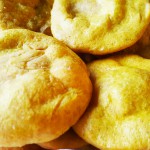



The Bara looks delicious! Nice one! 😉
Thanks, Ranette! Everything was delicious!
Eater just posted a short video about Doubles and specifically a small shop in Brooklyn called A&A Bake & Doubles, in case anybody wants some more Doubles information. http://www.eater.com/2015/12/22/10645090/doubles-trinidad-sandwich-brooklyn
That is not doubles
Thanks for the comment. I’m not happy with the way the baras came out for sure. If you have some specific suggestions for improvement I’d love to hear them!